U.S. Department of Transportation
Federal Highway Administration
1200 New Jersey Avenue, SE
Washington, DC 20590
202-366-4000
FHWA Resource Center
Click here for the PDF Version of the Environmental Quarterly
Volume 4, Issue 3
Summer 2008
LETTER FROM THE EDITOR
Dear Environmental Colleague,
This issue of Environmental Quarterly was held up a bit so that we could bring you a wrap up of the very recent FHWA National Environmental Conference. We also feature an interview with FHWA’s outgoing Director of the Office of Project Development and Environmental Review, Fred Skaer.
As always, if you have comments about a story or story ideas, please let us know.
Sincerely, Don Cote
Environment Technical Service Team (TST) Leader &
Editor–in-Chief
Phone: (720) 963-3210
E-mail: Don.Cote@fhwa.dot.gov
INSIDE
• A Conversation with Fred Skaer
• Michigan Workshop Sparks Improved Practices toward “Eco-Logical”
• FHWA National Environmental Conference
• Tribal Representatives Conduct Sensitivity Training Sessions in ND
• Environmental Calendar
A Conversation with Fred Skaer
Interview by Bethaney Bacher-Gresock, FHWA Office of Project Development and Environmental Review
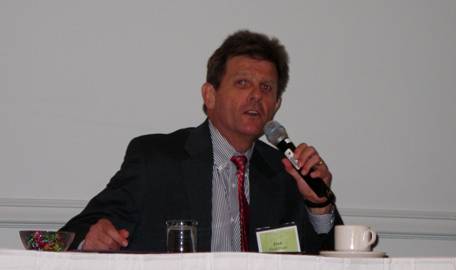
Caption: Photo of Fred Skaer speaking during a Priority Issues session at the 2008 FHWA National Environmental Conference. (Photo by Stephanie Stoermer.)
This summer we will wave farewell to Fred Skaer, Director of FHWA’s Office of Project Development and Environmental Review, as he takes the Retirement Exit off of the FHWA Superhighway. Fred’s FHWA journey has spanned 34 years, 1974-2008, and 11 FHWA Administrators. We’ll be celebrating Fred’s career at an event in the DOT Conference Center August 27, 2008. I recently had a chance to chat with Fred about his career and ask what advice he had to offer FHWA employees for the future.
Q: When and why did you choose to work for FHWA?
A: I joined FHWA in 1974 because the US was in a recession.
Q: How would a recession prompt you to apply to FHWA?
A: Well, when I graduated with my engineering degree I was actually looking to join a consulting firm. All the consulting firms were downsizing and limiting the number of new hires. So, I accepted a job as a Transportation Planner in FHWA’s Urban Planning Division instead. I did not follow the “traditional” training programs FHWA offered, even though I was strongly encouraged to. I created my own personal training program focusing in on the environment and planning areas as I went along.
Q: 34 years… wow. Many people today change jobs and companies several times in their careers. What has kept you at FHWA?
A: I’ve stayed with FHWA because I’ve truly enjoyed my work and the people I work with both within FHWA, DOT, and the stakeholders. I did look outside of FHWA a couple of times though. When I was your age or a little younger – my late 20s – I was seriously considering opening up an auto paint-job franchise in the King of Prussia, PA area. I met with the founder of AAMCO, Anthony A. Martino, the guy who started AAMCO Transmissions and later went on to start MAACO Auto Painting.
In the early 1980s, I changed jobs at FHWA and moved to the Caribbean to become the Planning & Research Engineer at the Puerto Rico Division Office. I returned from that adventure refreshed and ready to return to work in the Washington, DC area. I’ve spent time at the DC Division, MD Division, and in several capacities here at Headquarters. I’ve been an Office Director since 1999 or so.
Q: What has been one of the most challenging projects that you’ve been involved with at FHWA?
A: That’s a hard question. I’ve been involved in so many projects around the country, more as a trouble shooter than a project manager though. I can think of projects in almost every State that have been interesting, but one that sticks out is the 710 Freeway in the Los Angeles area of CA. The project has been around since before I even started at FHWA. I got involved in the mid-late 1990s. It’s a project that’s had a lot of controversy, it’s a high cost project, some local governments supported the project, some local governments opposed the project, and it’s been in court several times. There have been concerns about community disruptions and historic resources. The project is still ongoing.
Q: You talked about a challenging project; what would you describe as one of your greatest accomplishments at FHWA?
A: It’s always satisfying when you can look around and see that you’ve contributed to something that benefits our citizens, when we complete a transportation improvement project. I get satisfaction out of helping our agency navigate the issues that occur at the intersection of transportation and the environment.
Every time I drive the Fort McHenry Tunnel (I-95) in Baltimore, MD I think about this. This underwater tunnel was opened in November 1985. It was completed on time and under budget. They considered building a bridge, but that would have had significant environmental impacts and an adverse impact on the Fort McHenry Historic Site. I was a small part of this project, but I did work on it while I was in the Maryland FHWA Division Office.
Q: Are there any particular DOT programs or projects that you are proud of? That you think reflect the changing values of the American public?
A: I think that would be Transportation Enhancements. I wouldn’t call that a Federal program, it could be a State program though. Transportation Enhancements has forced DOT to broaden it’s thinking about what DOT is all about and how we can provide benefits to local communities outside of traditional highway projects. I think that Congress realized that it needed to do something to appeal to the needs and desires of the public. We’d promised to have the Interstate completed by 1969, but by the early 1980s it still wasn’t done. Congress cut back on some of the funding that could be used for highway mitigation projects. When ISTEA was established in 1991, Congress took a new viewpoint and said not only can you spend highway funds on mitigation; you can actually go above and beyond that and enhance the community.
When ISTEA was enacted, I specifically asked to have oversight of the implementation of Transportation Enhancements. I would later be introduced at conferences as “The guy who never met a TE project that he didn’t like.” Transportation Enhancements were established at a time when DOT spent almost no money for bicycle and pedestrian projects, and now we’ve increased that amount by orders of magnitude. These projects have increased our level of awareness, and broadened our view of what surface transportation projects really can be.
Q: Fred, I love that! You know that I got my first job out of college because I knew what the ISTEA acronym stood for, and that I worked exclusively on Transportation Enhancements? I don’t think I’d be here at FHWA if it weren’t for those types of projects.
A: (Smiles) Yep, I know.
Q: What do you think is the greatest challenge to us today, to use your words, at the intersection of transportation and the environment?
A: In our world, I think we are challenged by compartmentalized thinking. That means we want to either take full responsibility for something, or pass it off as someone else’s issue. The correct way to handle the situation is to recognize that you may be part of the problem and that you can be part of the solution too. This might mean that you have to work across organizational lines, different individual agendas, different levels of urgency, and sometimes limited resources. The key to this puzzle is finding out how you can help fit all these pieces together.
Q: Fred, onto your retirement. What are you going to do? What will you miss the least? What will you miss the most?
A: I’m looking forward to pursuing those things that I am most curious about, and you know I’m curious about a lot of things! I’m going to miss the “administrivia” of the job the least! I’ll miss the people the most. Most of us are busy enough in our lives that we take for granted how much of our need for social interaction is met at work. And, of course I am totally biased, but I think that our office is the best office in FHWA!
Q: Fred, one last question. Do you have any advice that you’d like to leave us all with?
A: Remember its all about language and culture. If you don’t understand another person’s language and you don’t appreciate their culture, then you are going to be unsuccessful in working with them. Appreciate everyone; you can learn a lot from them.
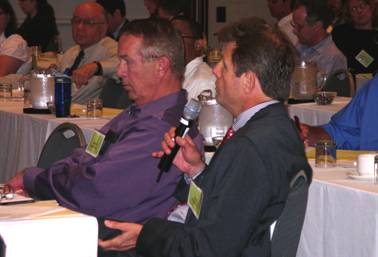
Caption: Photo of Fred Skaer commenting during the opening remarks of the National Environmental Conference. Don Cote, Team Manager for the Environment Technical Service Team sits to his right (left in photo ). (Photo by Stephanie Stoermer.)
Michigan Workshop Sparks Improved Practices toward “Eco-Logical” Approaches
Contributed by: David T. Williams, FHWA Michigan Division; Margaret Barondess, Michigan DOT; and Kimberly Majerus, FHWA-Resource Center
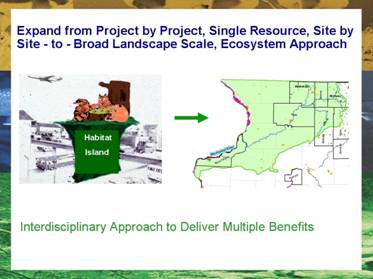
Caption: Graphic illustrating that Several FHWA and multi-agency initiatives, such as Eco-Logical, are expanding from a focus on single projects, sites, or resources to utilize broad landscape level approaches that consider multiple projects to support ecosystems, economies, and communities.
The Michigan Department of Transportation (MDOT) and FHWA Michigan Division Office coordinated and hosted an Eco-Logical Planning Process Workshop. The Workshop’s objectives were to gain an understanding of ecological planning in an effort to better link planning, the environment and NEPA.
What is Michigan trying to do?
Michigan is investigating the application of an Eco-logical approach to transportation decision-making starting with the planning process. Some of the goals of the workshop were to:
• Analyze existing processes and examine possible changes; and
• Better coordinate, integrate and implement ideas to include environmental priorities within transportation planning
This includes transportation decisions related to:
• Long-range transportation planning (LRTP) (statewide and metropolitan)
• Project development
• NEPA and environmental priorities
• Design
• Construction
• Operations and Maintenance
• Environmental and project commitments and priorities to implement
• Project management
Who Participated?
Workshop participants included Michigan DOT (MDOT), a Michigan MPO, and FHWA Michigan Division offices. Participants represented multiple disciplines including environmental sciences, transportation planning, engineering, and urban planning.
What happened at the workshop?
Presentations and discussion sessions capitalized on interdisciplinary participation across diverse areas of expertise, offices, and perspectives. Participants discussed:
• The multi-agency Eco-Logical publication “Eco-Logical: An Ecosystem Approach to Developing Infrastructure Projects” (*Eco-Logical 2006). The publication describes multi-agency and multi-level initiatives across national, regional, tribal, and local levels for planning and projects.
• Activities underway in Michigan reflecting the Eco-Logical approach and framework.
In addition, the Workshop explored the current decision-making processes and explored what may be needed to make the transition to an Eco-Logical Planning Process. For example:
• What is the level of detail and scale of decision-making and environmental data used for State long-rang planning, systems planning, corridor planning, and project development? How does the MPO process differ?
• How do we link planning with NEPA? What does it mean? What will it accomplish? How do we get started?
• What parts of the Eco-Logical eight-step framework does MDOT have and not have? How are they utilized? What are our greatest strengths and deficiencies?
• What are the advantages and challenges we see as we work towards implementing an ecosystem based planning process?
What are Michigan’s next steps?
Workshop results identified next steps toward further coordination internally across MDOT, FHWA, and MPO offices and staff. Michigan plans to continue its work with this interdisciplinary team to:
1. Identify Eco-Logical features that apply to the various phases of project development and delivery (planning, environmental documentation, design, construction, and maintenance) and how to link those in Michigan.
2. Develop inter-agency consultation procedures to better coordinate transportation planning with resource agencies.
3. Seek out funding (including FHWA Eco-Logical FY09 grant money) to support efforts.
FHWA-Michigan Division,
David T. Williams, Env. Program Mngr.
(517) 702-1820
Michigan DOT
Margaret Barondess, Env. Section Mngr.
(517) 335-2621
FHWA-Resource Center
Kimberly Majerus, Env. Technical Specialist
(708) 283-4346
* Eco-Logical 2006. Eco-Logical: An Ecosystem Approach to Developing Infrastructure Projects. Downloadable at: http://www.environment.fhwa.dot.gov/ecological/eco_index.asp.
See the complementary article in this issue of the Environmental Quarterly Newsletter entitled “2008 FHWA National Environmental Conference Highlights, PEL and Eco-Logical Session: FHWA Initiatives Dovetail Together”
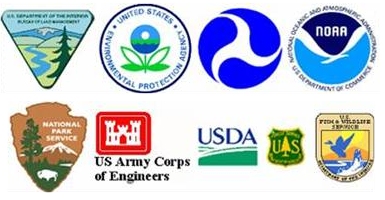
Caption: Logos of Several resource agency partners which contributed to the development of Eco-Logical, including U.S. Dept. of the Interior, the EPA, FHWA, NOAA, the National Park Service, U.S. Army Corps of Engineers, USDA, and US Fish and Wildlife Service.
2008 National FHWA Environmental Conference
Building on discussions that took place during previous environmental conferences in 2004 and 2006, the latest Federal Highway Administration (FHWA) Environmental Conference was held June 17-19, 2008, at the Washington Plaza Hotel in Washington DC. The timely theme of the 2008 Conference--FHWA's Role in a Changing Climate -- was also reinforced during pre-conference training sessions presented on June 16.
The conference not only provided participants with multiple opportunities to share knowledge and experiences regarding environment issues in the surface transportation arena, it provided leadership perspectives on the current status and future direction of FHWA's environmental stewardship and streamlining goals.
According to the organizers nearly 250 representatives from State Division Offices, Headquarters Offices, the Resource Center Environment Team, Federal Lands Highway Division offices, Legal Services offices, were present and attended the many sessions offered to the participants.
The 2008 Conference Planning Committee, comprised of staff from headquarters, field offices, Resource Centers, and Federal Lands Highway, was co-chaired by David Grachen, Resource Center ENV TST and Marlys Osterhues, Office of Project Development and Environmental Review. Other members of the Conference Planning Committee included Jeffrey Berna, New York Division Office; Emily Biondi, Office of Human and Natural Environment; Maryann Blouin, Western Legal Services; Robin Broils-Cox, Office of Real Estate Services; Dennis Durbin, Office of Natural and Human Environment; Denise King, DelMar Division Office; Cheryl Martin, Minnesota Division Office; Keith Moore, Office of Project Development and Environmental Review; Mark Schrader, North Dakota Division Office; Jienki Synn, Office of Planning; Jack VanDop, Eastern Federal Lands Highway; Rodney Vaughn, Resource Center ENV TST; Kelly Wade, Georgia Division Office; and Katiann Wong-Murillo, Resource Center ENV TST.
Outstanding logistical planning and support for the Conference was provided by US DOT Volpe Center staff, including Cassandra Allwell and Charity Coleman.
The conference presentations are available now on the conference website http://environment.fhwa.dot.gov/conference/. The conference proceedings will be posted by end of August.
Highlight from the National Environmental Conference:
Guidance on Cost Estimation and Management for Highway Projects
Contributed by Mary Ann Rondinella, FHWA Resource Center
During her presentation on fiscal constraint, Marlys Osterhues highlighted an important guidance document on cost estimation: National Highway Cooperative Research Program (NCHRP) Report 574, Guidance for Cost Estimation and Management for Highway Projects During Planning, Programming and Preconstruction. According to the Transportation Research Board (TRB), this guidance “explores approaches to cost estimation and management designed to overcome the root causes of cost escalation and to support the development of consistent and accurate project estimates through all phases of the development process, from long-range planning, through priority programming, and through project design.”
The guidance can be purchased or downloaded free of charge at the TRB website, at http://trb.org/news/blurb_detail.asp?id=7271
Highlight from the National Environmental Conference:
“PEL and Eco-Logical” Session: FHWA Initiatives Dovetail Together
Contributed by: Bethaney Bacher-Gresock, FHWA Headquarters; and Kimberly Majerus, FHWA Resource Center
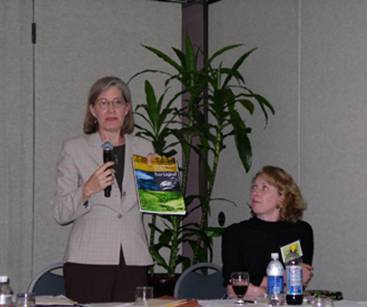
Caption: Photo of Kimberly Majerus introducing the multi-agency Eco-Logical publication as Bethaney Bacher-Gresock looks on. (Photo by Stephanie Stoermer.)
The Purpose of the “PEL and Eco-Logical Session”
The “PEL and Eco-Logical” session of the 2008 FHWA National Environmental Conference highlighted that many FHWA initiatives dovetail together to improve practices in support of SAFETEA-LU provisions, several Executive Orders (E.O.), and a Memorandum of Agreement (MOA) including:
• SAFETEA-LU Section 6001 and 6002
• Environmental Stewardship and Transportation Infrastructure Project Reviews (E.O. 13274)
• Facilitation of Cooperative Conservation (E.O. 13352)
• Multi-Agency MOA for an Ecosystem Approach
The session presentations discussed a goal of improved transportation decision-making within transportation planning, project development, and project delivery by capitalizing upon methods to better integrate planning efforts across national, tribal, regional, state, and local levels resulting in environmental and transportation benefits. The presentations made it apparent that the integration of these efforts dovetails nicely with several FHWA initiatives including:
• Planning and Environmental Linkages/Linking Planning and NEPA
• Context Sensitive Solutions
• Environmental Streamlining and Stewardship
• Eco-Logical: An Ecosystem Approach to Developing Infrastructure Projects (Multi-agency publication and initiative) *
For example, the use of the Eco-Logical approach represents one way to Link Planning and NEPA which often results in the use of Context Sensitive Solutions and more effective Environmental Streamlining and Stewardship and better transportation decision-making and projects.
The Message of the “PEL and Eco-Logical” Session
Panelists from FHWA Headquarters, Colorado Division Office, and the Resource Center highlighted ongoing efforts that have been underway for several years by using existing funding to improve transportation decision-making. As an example of efforts using existing funds see the complementary article in this newsletter entitled “Michigan Workshop Sparks Improved Practices toward Eco-Logical Approaches.”
In addition, the PEL and Eco-Logical session introduced newly launched efforts to catalyze improved practices as well as the FHWA FY07 “Eco-Logical” grant solicitation and selection to provide $1.4 million in seed funding for fifteen “Eco-Logical” pilot projects and the next FHWA solicitation and funding for Eco-Logical pilot projects in FY09.
Details on the content and presentations delivered during the PEL and Eco-Logical session will be posted in the future on the 2008 FHWA National Environmental Conference website. Future Environmental Quarterly Newsletters will provide updates on availability of detailed session information.
To Move Forward with FHWA Initiatives
The panelists both illustrated and invited participation from the national to local levels, across agencies and organizations involving the public and private sector from long-range planning all the way through to project development and project delivery efforts. Participation includes improvements to existing practices and processes as well as identifying and filling gaps and advancing use of newly available innovations and efficiencies that can expand benefits, reduce project time and cost, and produce higher quality outcomes for transportation programs, planning, and projects. Watch for future issues of the FHWA Environmental Quarterly Newsletter for updates on progress and momentum across the nation.
Note: the “Eco-Logical” Interagency Steering Committee received a 2007 FHWA Administrator’s Award
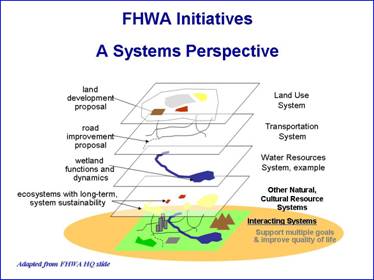
Caption: Graphic showing FHWA initiatives using a systems perspective toward a foundation of interacting systems (shown at bottom/base of this graphic) that includes land use, intermodal transportation, natural, cultural, and socio-economic systems deliver quality of life and multiple benefits for the long-term.
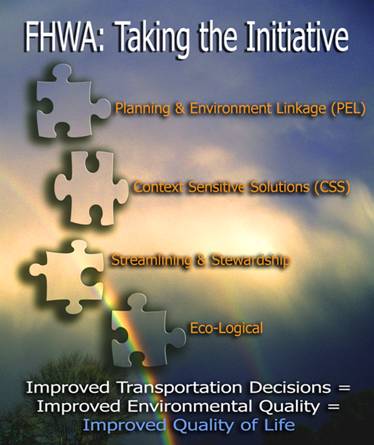
Caption: Graphic showing FHWA Initiatives and Efforts Dovetail Together. (Graphic designed by Stephanie Stoermer.) Graphic reads: FHWA: Taking the initiative: Planning and Environment Linkage (PEL), Context Sensitive Solutions (CSS), Streamlining and Stewardship, Eco-Logical. Improved Transportation Decisions = Improved Environmental Quality = Improved Quality of Life.
HONORING COMMITMENTS: TRIBAL REPRESENTATIVES CONDUCT SENSITIVITY TRAINING SESSIONS IN NORTH DAKOTA
By Stephanie M. Stoermer, FHWA Resource Center
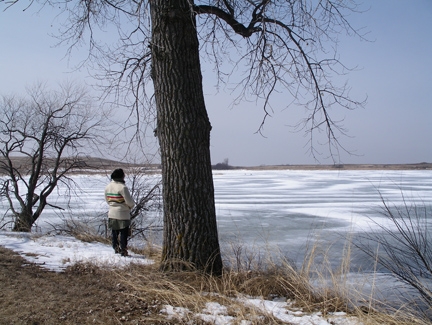
Caption: Photo of an unidentified fieldtrip participant contemplates the lake at Whitestone Hill Battlefield State Historic Site. Soldiers tossed heavy metal objects including kettles and cooking utensils into the lake so that they could not be retrieved. (Photo by Stephanie Stoermer.)
Despite a tenuous and often challenging relationship between American Indians and the archeological discipline, contemporary archeologists continue to retrieve, analyze, and attempt to explain the material culture of ancestral indigenous peoples. Such investigations are often undertaken as part of the environmental studies needed for proposed transportation projects to assure compliance with the National Environmental Policy Act (NEPA), the National Historic Preservation Act (NHPA) and other environmental laws.
Because the fieldwork, analysis, and written interpretation of indigenous cultural sites are often conducted without meaningful consideration of traditional cultural, social, and spiritual views, Native American concerns and sensitivities are frequently either overlooked or completely ignored. In hopes of resolving this unfortunate situation, there have been numerous efforts over the past several decades to identify the underlying causes of potential conflicts as well as to identify potential solutions.
Many of the more recent efforts to sensitize archeologists to Native American perspectives have been initiated because of concerns related to compliance with the evolving federal laws and regulations that have placed increasing emphasis on American Indian concerns about cultural resources, preservation of sacred places, the ongoing destruction of places and things of cultural value, and the effects of such destruction on the respective cultural identities of the Tribes engaged in. consultation with federal and state agencies.
Other efforts have been driven by a strong desire on the part of American Indians for the dominant culture to acknowledge and understand how centuries of genocide, cultural destruction and prejudice—manifested by historical trauma--continue to affect the spiritual, mental and physical health of contemporary Native Americans and their communities.
Some of the major causes contributing to the levels of mistrust between archaeologists and American Indians include:
1. historical trauma
2. different conceptions of the past
3. lack of communication between researchers and descendant communities
4. attitude
5. ethical issues
6. confidentiality
7. disregard of cultural identities
8. disregard of traditional knowledge and practices
A major commitment identified in the Section 106 Programmatic Agreement for Tribal Consultation in North Dakota (PA) is to pursue cross-cultural training opportunities in order to continue to facilitate effective consultation with the participating Tribes. Tribal representatives of the Tribal Consultation Committee (TCC) have long identified sensitivity training for archeologists working in Tribal ancestral homelands as being of the highest priority.
Since the PA was executed in November, 2006, the TCC--composed of representatives from the consulting Tribes, the North Dakota Department of Transportation (NDDOT), and the Federal Highway Administration (FHWA) North Dakota Division—has been working together to develop cultural sensitivity training sessions directed at archeologists and resource managers. The goal of such training is to provide cultural resource consultants who work in the northern Great Plains with a better understanding of Native American perspectives so that they will be more sensitive and attuned to tribal life ways, values, and protocols as they conduct their investigations and disseminate their findings.
As a result of the collaborative efforts of the TCC members, sensitivity training was conducted on April 8-9, 2008 in Bismarck, North Dakota. Participants included representatives from the National Guard and the U.S. Army Corps of Engineers as well as archeological and environmental consulting firms. Over the course of two days, sensitivity training participants were not only exposed to new ways of considering archeological evidence, they were also reminded that different cultural perspectives and worldviews do not exclude cooperation and collaboration.
The April 8 sensitivity training was led by several TCC Tribal representatives and focused on key areas of concern previously identified during TCC meetings. After a hearty welcome and opening remarks from Jeani Borchert, NDDOT Tribal Liaison and Mark Schrader, FHWA North Dakota Division, Conrad Fisher, Tribal Historic Preservation Officer (THPO) for the Northern Cheyenne began the morning training session with an intriguing pre-test exercise and led a discussion of stereotypes.
Next, Mr. Fisher gave a brief overview of Federal Indian policy. Curley Youpee, Ft. Peck Cultural Resource Director, then provided additional insights regarding Federal Indian policy and the issue of equal protection and liberties. Other TCC members related how the policies affected the Tribes in the past, and continue to affect them today.
The morning session concluded with a role-playing exercise led by Mr. Youpee and a group discussion about the appropriate levels of interaction with the Tribes. The role-playing exercise was very enlightening and certainly afforded non-Indian participants a brief glimpse of what it is like when certain roles are reversed. Although at times somewhat discomforting, Mr. Youpee’s exercise undoubtedly helped to facilitate a more open and receptive group dynamic during the subsequent afternoon session.
The afternoon training session addressed two very sensitive and intertwined topics that archeologists and others need remain acutely aware of, namely, confidentiality and traditional knowledge. The TCC tribal representatives conveyed two key messages: (1) that there are certain kinds of knowledge and information are considered culturally inappropriate to disclose or to discuss unless certain strict protocols are followed; and (2) when and if such information is shared, it is usually shared in order to protect cultural heritage and as such it must be kept in strict confidence.
Elgin CrowsBreast, Cultural Resource Program Director and Calvin Grinnell, Cultural Resource Specialist, both from the Three Affiliated Tribes (Mandan, Hidatsa, and Arikara Nation) introduced the subject of traditional knowledge—the kind of knowledge that has been passed down orally from generation to generation. Traditional knowledge includes beliefs, values and practices that help sustain cultural continuity, and when it is lost through acculturation or misappropriated by others, the effects on individuals as well as cultures can be devastating.
William Ambrose Littleghost, Cultural Adviser, Spirit Lake Nation and George Ironshield from the Standing Rock Sioux Tribe THPO Office spoke about sacred issues and their implications for archeological investigations. Later in the afternoon session, Mr. Littleghost and his wife, Mrs. Aileen Littleghost talked about the importance of respect and gender roles, describing their experiences as Tribal elders who are passing on traditional knowledge and lifeways to the next generation.
TCC Tribal representatives, including Tim Mentz Sr., Standing Rock Sioux Tribe THPO also discussed the need for a thoughtful and careful identification process. Mr. Mentz gave an excellent presentation on the types of sites that are often missed because non-Indian archeologists are grounded in theoretical constructs rather than in traditional knowledge. As TCC Tribal representatives have often pointed out, identification efforts need to consider the active participation of trained tribal monitors when it is appropriate because there are certain kinds of sites that academically trained archeologists may overlook simply because they do not recognize them as sites.
The second day of sensitivity training consisted of a field trip to the Whitestone Hill Battlefield State Historic Site, about twenty-three miles southeast of Kulm, in Dickey Co., North Dakota. According to the North Dakota Historical Society, Whitestone Hill “…marks the scene of the fiercest clash between Indians and white soldiers in North Dakota.”
During the long bus ride, field trip participants learned more about the significance of Whitestone Hill. Alycia Madison-White Eagle (Standing Rock Sioux Tribe), a student at United Tribes Technical College, provided an in-depth overview. Ms. Madison-White Eagle has been researching the battle and its aftermath. She plans to produce a documentary based on her research that will describe the events that occurred at Whitestone Hill from a Tribal perspective. It is hoped that such a documentary will reach a wider audience and will help provide a more balanced interpretation of the site.
Accounts of the battle vary, but it is generally acknowledged that General Alfred Sully's troops attacked a camp of Yanktonai, Dakota, Hunkpapa Lakota, and Blackfeet (Sihasapa Lakota) on September 3, 1863. Although historians often describe the attack as part of a military mission to punish tribes who had taken part in the Dakota Conflict of 1862, the attack on the encampment at Whitestone Hill was unprovoked. The descendants of the people encamped at Whitestone Hill that day are deeply affected by remembrance of this massacre.
In the aftermath of the battle, Sully’s troops undertook a concerted effort to destroy the beleaguered survivors’ lodges, food, and household goods. The troops burned 500,000 or more pounds of dried buffalo meat that would have sustained the victims of the attack through the winter. Soldiers also tossed heavy metal objects including kettles and cooking utensils into the lake so that they could not be retrieved. Sully’s brutal “scorched earth policy” resulted in such destruction that the survivors were left without food or shelter at a very critical time of the year.
The remoteness of Whitestone Hill evokes a sense of foreboding and unspeakable loss that was heightened by bone-chilling winds. The actual site is stark and unremarkable, except for a low hill crowned with a large monument commemorating the 20 soldiers who died. Ironically, there is a much smaller marker at the bottom of the hill for the approximately 200 or more men, women, and children who perished.
Visiting Whitestone Hill is a moving experience—particularly when one recalls that there are two very different interpretations of the events that took place there. As recounted by historians, the most readily accessible interpretation draws from stories in Harper’s Weekly, military records, and the tales of old soldiers. By using terms like “battle” and “military engagement” to glorify the tenets of Manifest Destiny, this interpretation only serves to perpetuate the misguided and prejudiced views of a dominant culture.
The other interpretation is not so well known because it is part of an oral tradition and has been passed from generation to generation by the descendants of those who survived the attack. For those descendants, the events at Whitestone Hill can only be as a massacre. Perhaps a day will come when voices long silenced will rise again to tell the story of the victims as well as the “victors.”
On the cold April afternoon of our visit, the site seemed a very fitting place to reflect on the unique insights and perspectives that had been so openly shared by the TCC tribal representatives during the training sessions. Although the sensitivity training for archeologists is only one of several important cross-cultural initiatives that the TCC is pursuing or plans to pursue, it was a critical step in following through on the long-term commitments made the in the PA. By identifying and responding to the need for such training, the TCC, the NDDOT and the FHWA North Dakota Division have once again demonstrated the benefits that working together in a proactive and collaborative manner can yield.
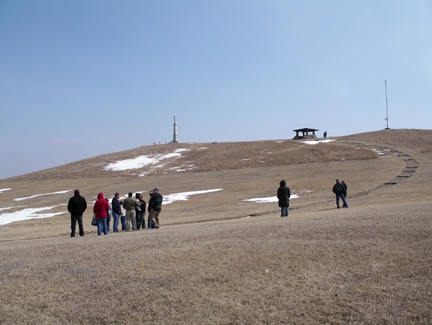
Caption: Photo of fieldtrip participants at Whitestone Hill. (Photo by Stephanie Stoermer.)
Caption: What’s Going On?
Here are a few of the upcoming events of interest to the environmental community:
August 2008
July 28 - August 1
TRB ADC10, ADC30 and ADA40 Environment Joint Summer Meeting
Denver CO
September 2008
September 2 - 5
ProWalk/ProBike 2008
Seattle WA
September 4-6
Modernism in the Northwest: Mid-Century Architecture- Identification and Evaluation
Boise, ID
September 7 – 10
Summer meeting of ADC50-TRB Committee on Archeology and Historic Preservation
Saratoga Springs, NY
September 11-14
Preserving the Historic Road
Albuquerque, NM
September 21 - 24
3rd Biennial Northeast Transportation & Wildlife Conference
Meredith NH
September 22- 25
Soil Erosion and Sediment Control Peer Exchange
IN, MN, WI
October 2008
October 21 - 25
National Preservation Conference
Tulsa OK
http://www.eshow2000.com/nthp/
November 2008
November 2
Daylight Saving Time Ends
November 13 - 14
Road & Dust Management Practices and Future Needs Conference
San Antonio TX
www.meetingsnorthwest.com/dustconference.htm
For additional conferences and events, see www.fhwa.dot.gov/hep/calendar.htm.
CONTACT INFORMATION:
Federal Highway Administration
Resource Center
Editor-in-Chief
Don Dote, Environment Technical Service Team Manager
Phone: (720) 963-3210/Fax: (720) 963-3041
E-mail: don.cote@dot.gov
Editorial Board Members:
Bethaney Bacher-Gresock, Environmental Protection Specialist
Phone: (202) 366-4196/ Fax: (202) 366-7660
E-mail: bethaney.bacher-gresock@dot.gov
Brian Smith, Biology/Water Quality Specialist
Phone: (708) 283-3553/Fax: (708) 283-3501
E-mail: brian.smith@dot.gov
Stephanie Stoermer, Environmental Program Specialist/Archeologist
Phone: (720) 963-3218/Fax: (720) 963-3232
E-mail: stephanie.stoermer@dot.gov
Deborah Suciu-Smith, Environmental Program Specialist
Phone: (717) 221-3785/Fax: (717) 221-3494
deborah.suciu.smith@dot.gov
Managing Editor
Marie Roybal, Marketing Specialist
Phone: (720) 963-3241/Fax: (720) 963-3232
E-mail: marie.roybal@dot.gov
Production Schedule:
Due to our Quarterly publication schedule, all article submissions for future issues are due to the Editor-In-Chief by the 10th of March, June, September, and/or December
Getting the news:
*If you would like to receive this newsletter electronically, please send your email address to: marie.roybal@dot.gov